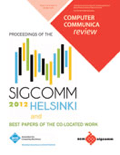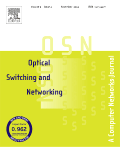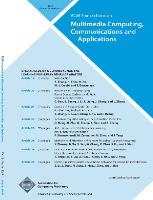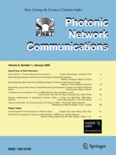
ACM SIGCOMM Computer Communication Review
Scope & Guideline
Exploring innovations in networks and software.
Introduction
Aims and Scopes
- Networking Protocols and Architectures:
Focuses on the design, implementation, and evaluation of networking protocols and architectures, including TCP/IP stacks and modern networking paradigms such as SDN (Software Defined Networking) and eBPF (extended Berkeley Packet Filter). - Network Performance and Measurement:
Addresses issues related to performance metrics, traffic measurement, and analysis, emphasizing empirical studies and data-driven approaches to understand networking environments. - Security and Privacy in Networking:
Explores the challenges and solutions related to security vulnerabilities, privacy concerns, and the implications of data protection in networking contexts. - Emerging Technologies and Applications:
Investigates the impact of emerging technologies, such as machine learning, edge computing, and IoT (Internet of Things), on networking practices and their potential applications. - Community and Policy Engagement:
Engages with broader issues affecting the networking community, including policy discussions, standards development, and the future of the public Internet.
Trending and Emerging
- Integrating Machine Learning in Networking:
Research on employing machine learning techniques for various networking applications, such as traffic management and security, is on the rise, highlighting the intersection of AI and networking. - Resilience and Survivability in Network Architecture:
There is an increasing focus on designing networks that can withstand failures and attacks, with discussions on re-architecting the Internet for enhanced survivability. - Privacy-Preserving Technologies:
Emerging themes around privacy-preserving technologies indicate a growing recognition of the need for secure data handling and user privacy in networking practices. - In-Network Computation and Processing:
The exploration of in-network processing capabilities, such as machine learning inference directly within the network, is gaining traction, which could revolutionize data handling and efficiency. - Community Engagement and Policy Discussions:
A trend towards addressing community and policy issues within networking research reflects a broader concern about the societal impacts of technology and the importance of collaborative governance.
Declining or Waning
- Traditional Network Management Techniques:
There is a noticeable reduction in research focusing on conventional network management approaches, as the field shifts towards more dynamic, programmable networks and automation. - IPv4 Address Management:
Interest in IPv4-specific topics has diminished, likely due to the increasing adoption of IPv6 and the need for more innovative approaches to address allocation and management. - Standardized Protocols without Adaptation:
Research on rigidly standardized protocols without consideration for adaptation to specific environments or applications has decreased, as there is a growing preference for flexible, customizable solutions.
Similar Journals

Optical Switching and Networking
Connecting Scholars Through Optical InsightsOptical Switching and Networking is a prestigious academic journal published by ELSEVIER, focusing on cutting-edge research and developments in the field of optical communications and networking. With an impressive impact factor and quartile ranking, this journal is recognized as a vital resource for professionals and researchers in Computer Networks and Communications and Electrical and Electronic Engineering, positioned in the Q2 category according to the latest metrics. Aiming to foster innovation and knowledge exchange among scholars, the journal covers a diverse range of topics, from optical switching mechanisms to the latest advancements in network architecture. Researchers benefiting from its accessible content will find it an invaluable platform for advancing their work and engaging with a global community of experts. For those seeking to enhance their understanding and contribute to the academic discourse in these rapidly evolving fields, Optical Switching and Networking serves as an essential conduit for high-quality research and ideas.

WIRELESS NETWORKS
Advancing the Frontiers of Wireless CommunicationWIRELESS NETWORKS is a prestigious journal published by Springer, focusing on cutting-edge research in the domains of wireless communication, computer networks, and information systems. Established in 1995 and set to converge its influential contributions until 2024, this journal has rapidly ascended to a Q2 category ranking in the fields of Computer Networks and Communications, Electrical and Electronic Engineering, and Information Systems, reflecting its significant role in advancing knowledge and innovation—ranked 75th, 151st, and 84th respectively in their fields by Scopus. Researchers and professionals alike value its contribution to the discourse on wireless technologies, making it a vital resource for professionals and students eager to stay abreast of the latest trends and findings. Although it does not offer open access, the insights gleaned from its articles are invaluable for tackling the challenges of modern communications and ensuring the efficient use of wireless networks.

Ad Hoc & Sensor Wireless Networks
Advancing wireless innovation through cutting-edge research.Ad Hoc & Sensor Wireless Networks, an esteemed journal published by OLD CITY PUBLISHING INC, provides a dedicated platform for the dissemination of pioneering research in the realms of computer science, electrical and electronic engineering, and instrumentation. With an ISSN of 1551-9899 and an E-ISSN of 1552-0633, this journal has established itself as a crucial resource for scholars and practitioners alike, actively contributing to the advancements in ad hoc networks and wireless sensor technologies. It holds a commendable position within the third quartile in its respective fields, with Scopus rankings reflecting its relevance in the academic community. As a publicly accessible source of valuable insights, the journal aims to inspire innovation and facilitate progress across various disciplines. Situated in Philadelphia, PA, and converging its efforts from 2005 to 2024, Ad Hoc & Sensor Wireless Networks continues to be a beacon of research excellence, impacting both theoretical and practical domains in technology.

ACM Transactions on Multimedia Computing Communications and Applications
Redefining the Landscape of Multimedia Research.ACM Transactions on Multimedia Computing, Communications, and Applications is a premier journal published by the Association for Computing Machinery (ACM), pivotal in the field of Computer Networks and Communications and Hardware and Architecture. With an impressive 2023 impact factor, this journal holds a commendable Q1 ranking in both its categories, solidifying its significance within the research community. The journal welcomes high-quality research that explores innovative technologies and methodologies in multimedia computing and communication as well as applications that enhance user experiences. While it remains a subscription-based journal, it provides unparalleled access to groundbreaking studies, serving as an essential resource for researchers, professionals, and students seeking to stay at the forefront of multimedia technologies. Spanning from 2005 to 2024, the journal offers a rich repository of knowledge and is committed to fostering advancements in the multimedia domain.

PHOTONIC NETWORK COMMUNICATIONS
Pioneering Research in Optics and Communication Systems.PHOTONIC NETWORK COMMUNICATIONS, published by SPRINGER, is an esteemed journal dedicated to advancing the fields of atomic and molecular physics, optics, computer networks and communications, as well as electrical and electronic engineering. Since its inception in 1999, this journal has become a pivotal platform for researchers and professionals to disseminate innovative findings and foster collaborative discourse within these dynamic disciplines. With a current impact factor that underscores its relevance, this publication has consistently ranked in the third quartile across multiple academic categories for 2023, indicating its significance in the research community. Although it operates under a subscription model, it maintains high visibility among its peers, contributing to impactful advancements in hardware and architecture, software, and photon-based communication systems. With the support of a diverse international readership, PHOTONIC NETWORK COMMUNICATIONS continues to play a crucial role in shaping the future of photonics and network communications.

JOURNAL OF HIGH SPEED NETWORKS
Exploring Innovations in High-Speed NetworkingJOURNAL OF HIGH SPEED NETWORKS, published by IOS PRESS in the Netherlands, serves as a vital platform for the dissemination of cutting-edge research in the fields of Computer Networks and Communications, Hardware and Architecture, and Information Systems. With an ISSN of 0926-6801 and an E-ISSN of 1875-8940, this journal has been integral to the academic community since its inception in 1992, providing a dedicated space for innovative studies and findings. Although categorized in the Q4 quartile in its various fields for 2023, the journal remains committed to advancing knowledge and fostering collaboration among researchers, professionals, and students alike. By offering insights into the complexities of high-speed networks and related technologies, the JOURNAL OF HIGH SPEED NETWORKS continues to play a significant role in shaping the future of digital communications and infrastructure. This journal does not operate as an open-access journal; however, it remains a key resource for professionals seeking to stay informed on the latest developments and trends in this fast-evolving discipline.

International Journal of Computers Communications & Control
Elevating Standards in Computer Networks and Control SystemsThe International Journal of Computers Communications & Control, with ISSN 1841-9836 and E-ISSN 1841-9844, is a leading peer-reviewed journal published by CCC PUBL-AGORA UNIV since 2006, dedicated to fostering advancements in the fields of computational theory, computer networks, and applications. Based in Romania, this open access journal is committed to providing a platform for researchers, professionals, and students to disseminate cutting-edge research, innovative methodologies, and significant findings within a rapidly evolving technological landscape. As evidenced by its growing impact, the journal has achieved notable rankings in Scopus, including the 77th percentile in Computational Theory and Mathematics and 62nd percentiles in both Computer Networks and Communications and Computer Science Applications, with category quartiles reflecting its esteemed position in the academic community. The scope is broad, embracing interdisciplinary approaches that connect various dimensions of computer science and communication technologies, making it an essential resource for those looking to stay at the forefront of research and development in these areas.

Frontiers in Communications and Networks
Leading the Charge in Communication TechnologiesFrontiers in Communications and Networks is a prominent open-access journal published by FRONTIERS MEDIA SA, established in 2020 and positioned in the heart of Switzerland. As an interdisciplinary platform, it focuses on advancing research related to computer networks, communications, and signal processing, providing a critical forum for innovative findings and developments in these rapidly evolving fields. With an impressive Q1 ranking in Computer Networks and Communications and a Q2 ranking in Signal Processing as of 2023, this journal is highly regarded among scholars and practitioners seeking to disseminate their work to a broad audience. By offering open-access options, it ensures that the research is widely available, fostering collaboration and knowledge sharing across the globe. Researchers, professionals, and students are encouraged to engage with the journal as it aims to encapsulate the burgeoning advancements shaping our digital communication landscape.

Proceedings of the ACM on Measurement and Analysis of Computing Systems
Fostering Excellence in Computing Systems Analysis and ReliabilityProceedings of the ACM on Measurement and Analysis of Computing Systems, published by the Association for Computing Machinery, is a pivotal journal in the realms of Computer Science and Engineering, particularly esteemed for its comprehensive focus within the fields of Computer Networks and Communications, Hardware and Architecture, and Safety, Risk, Reliability and Quality. With an impactful presence since its convergence in 2019—and now spanning from 2021 to 2024—this journal upholds rigorous standards, reflected in its classification as Q1 in Computer Science (miscellaneous) and in key safety-related categories. Researchers and professionals will find the journal's emphasis on measurement and analytical solutions critical for advancing computational efficiency and system reliability in real-world applications. The journal does not currently have open access, maintaining its academic rigor and exclusive content that aims to serve the tech-savvy community dedicated to exploring and addressing the challenges within modern computing systems. With Scopus rankings demonstrating a steady impact in the field, particularly recognised within safety and reliability domains, the Proceedings of the ACM stands as an indispensable resource for those seeking to deepen their expertise and contribute to the evolving landscape of computing research.

Cluster Computing-The Journal of Networks Software Tools and Applications
Connecting Ideas, Driving Applications in ComputingCluster Computing - The Journal of Networks Software Tools and Applications, published by Springer, is a premier academic journal catering to the vibrant fields of computer networks and software technologies. With an impressive impact factor and recognized as a Q1 journal in both Computer Networks and Communications and Software categories for 2023, it ranks within the top echelons of its field, boasting a Scopus rank of #50 out of 395 and #59 out of 407 respectively, highlighting its influence and reach. The journal, which has been in continuous publication since 2005, serves as a vital platform for groundbreaking research, offering insightful articles and tools that drive innovation in network computing. Researchers, professionals, and students are invited to contribute to and benefit from the dynamic discourse presented in this journal, which is pivotal for advancing knowledge and enhancing practical applications in a rapidly evolving technological landscape.